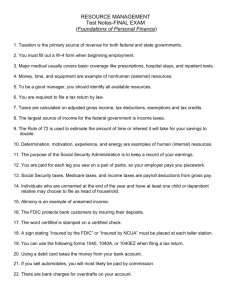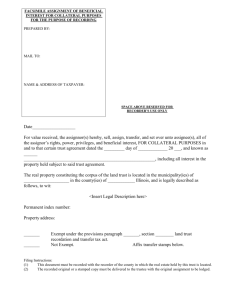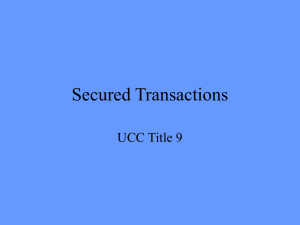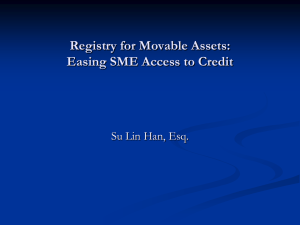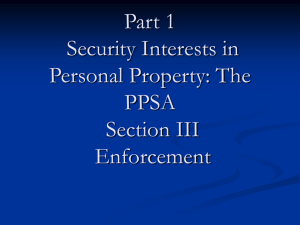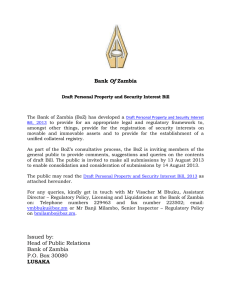Session B-1 1 - (Jamie Bowman)
advertisement
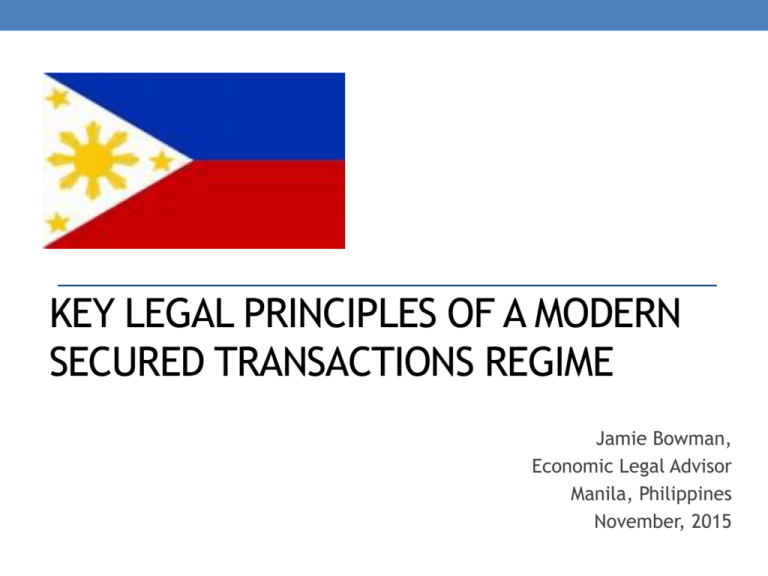
KEY LEGAL PRINCIPLES OF A MODERN SECURED TRANSACTIONS REGIME Jamie Bowman, Economic Legal Advisor Manila, Philippines November, 2015 Presentation Overview Goals & Benefits Current Regime in the Philippines International Best Practices Reform Components Key Legal Principles Registry Standards Approach to Legal Reform Questions & Answers Review – Goals & Benefits Goals: To increase access to credit for businesses and consumers, by reducing the risk to lenders, Facilitate the use of movable assets as collateral for loans and credit, By increasing certainty of repayment and debt satisfaction through realization of movable property collateral. Some benefits: Increased available credit, improved loan terms: longer duration, improved loan-to-value ratios and lower interest rates. Who else has reformed…? (short list) Afghanistan India Albania Lao PDR (coming soon) Australia Marshall Islands Bosnia-Herzegovina Mexico Cambodia New Zealand Canada Romania China (receivables and financial leases) Sri Lanka Ghana United States Guatemala Vanuatu Honduras Vietnam Current Regime in Philippines Legal Framework: Chattels Mortgage Law (1906) Provisions of the Civil Code Provisions of the Criminal Code Supreme Court Rulings Registry Deeds Registry “It works….” Telephones - 1906 Ford “Model T” 1906 Telephones - 2015 Google Selfdriving car 2015 Assessments of the Current Regime “This is an old law…” Philippine Law – Simplified “The foregoing discussion has revealed that the framework governing security over personal property in the Philippines is far from a successful story of doctrinal or jurisprudential fusion between Spanish civil law and US common law. ” Securities Property in the Philippines: A States Common Law Imbroglio “Its only due to the ingenuity of the local lawyers that the system works as well as it does…” BizCLIR SOURCES OF INTERNATIONAL BEST PRACTICES UNCITRAL Legislative Guide on Secured Transactions World Bank Principles on Insolvency and Creditors Rights IFC Guide on Secured Transactions and Collateral Registries Reform Components A legal framework that incorporates best practice principles including: 1. 2. 3. 4. 5. Broad Scope (collateral, obligations & interests) Simple creation Effective publicity Priorities Effective & inexpensive enforcement mechanisms An unified, electronic registry that facilitates the access to information, keeps costs low and limits corruption. Training for banks, lenders, borrowers, judges, attorneys, and other users of the regime. Principle 1 – Broad Scope The broader the coverage of the law regarding collateral, interests and obligations, the more credit that will be extended…! The legal framework should cover: - all types of movable property as collateral, - all types of obligations, and, - all types of security interests. Rules regarding Collateral Broadly define collateral: - All types of movable property - Tangible (all types of equipment, machinery, goods, crops, timber, livestock, etc.) - Intangible (Receivables, intellectual property rights) - Both presently owned and acquired in the future Exclusions (clearly state in the law): Immovable property Property subject to separate regimes Ships and wages Description of Collateral The Law should allow collateral to be described “generally”. The terms “all equipment” and “all inventory” should be sufficient. Benefits: - Allows parties to avoid costly investigation when entering contracts; - Avoids litigation over status of particular assets; - Facilitates lending on inventory and receivables; - Avoids time consuming registration and amendments. Types of Interests Law should cover any type of transaction that creates a right in movable property meant to secure the performance of an obligation: - Chattels mortgage* - Non-possessory pledges - Financial* and certain operational leases - Trust receipts* - Assignment by way of security (receivables)* - Conditional sales* - Sale-lease backs* - Others… * “Other” interests (avoid surprise interests): - Tax liens - Court judgments Common in the Philippines Multiple Interests & Proceeds Best practice is to allow multiple interests in the same collateral: - Allows the debtor to use the full value of its assets to maximize available credit - Negative “pledges” should be discouraged Best practice is to allow the interest to follow the “proceeds” of the collateral. - Right should extend to whatever type or proceeds are received upon disposition of collateral - Right to proceeds should be automatic Obligations The Law should cover any type of obligation the performance of which is secured by an interest in movable property: - Present & future Monetary & Non-monetary Determinate & determinable Conditional & unconditional Fixed & floating Monetary obligations should include demand loans, term loans and lines of credit Principle 2 – Simple Creation Best practice is to simplify and expedite the creation of security interest, imposing no unnecessary burdens on the parties: - Keeps costs low - Encourages use Only minimal requirements: - Written agreement signed by the debtor (Writing requirement can be satisfied by electronic correspondence) - Identifies collateral and the secured obligation - no special terminology - no notarization - no other formalities (ie affidavit of good faith) Principle 3 – Perfection (Publicity) What - “Perfection” is an additional step taken after the interest is created that makes it effective against the claims of third parties. Why - Unfair to hold other creditors accountable for interests that are not public. How - Preferred means of perfection is registration. But perfection may also be achieved through possession and control. Should apply to “other interests” (tax liens, etc.) to avoid “surprise” claims, which improves lender’s certainty. Principle 4 – Priority “Priority” rules determine the sequence in which competing claims to the same collateral will be satisfied if the debtor defaults. Law must address a wide variety of situations & certain exceptions that address business realities. Priority rules must be clear and precise to avoid litigation. - General Rule: “First in time, first in right” - Limited exceptions Allows creditor to evaluate the risk of lending (vis a vis other potential claimants) at the time the decision to extend credit it made. Inclusion of “Other” Interests .JPB Bank Loan $50,000 Collateral Value $75,000 First in Time; first in Right..! #1 Tax Lien Loan $20,000 #2 Court Judgment $50,000 #3 JPB Bank Loan $50,000 =? Exceptions to “First in Time” Exceptions address the realities of doing business in today’s world: Purchase money mortgage (Acquisition Finance): Involves the rights of a creditor funding the acquisition of specific property, which may conflict with a prior interest. Right of retention: Involves a person who provides value to the collateral. May retain possession until paid, even if there is another security interest of lien. (Example: mechanic’s lien) Commingled goods: Interests in goods that becomes “commingled” with other goods. Crops and fixtures: Unique issues raised by the land laws Purchase Money Mortgage - Example San Jose Tire Store • Owner has an existing loan secured by “all inventory & equipment.” • Owner needs new equipment to expand services and increase business. • Existing lender won’t extend additional credit, or terms aren’t favorable to owner. • Owner goes to a vendor, and purchases needed equipment on credit from vendor, secured by new equipment. • Vendor has right to “new” equipment upon owner default. Principle 5 – Enforcement Speedy, effective and inexpensive enforcement mechanisms, including “non-judicial” foreclosure are essential to realizing security interest in collateral. Key principles: • Immediate right to possession by creditor upon default by debtor/ or abbreviated judicial process – no breach of peace. • Disposition (private or public sale) of the collateral by the creditor – No government official involved - Public Action not Required • Distribution of proceeds in priority sequence. • Protection of rights of the debtor during enforcement. Debtor Rights & Dealing with Creditors Debtor should be entitled to an accounting of the debt. Debtor should be allowed to reinstate loan by paying any and all amounts in arrears + expenses incurred. Allow for redemption before sale: debtor or others with an interest in collateral can redeem by paying entire amount of debt. Significant penalties should be levied on creditors that violate the enforcement procedures. Registry Standards (Overview) Accessibility: Registries should be accessible to both registrants and searchers from widely available access points, seven days a week, 24 hours a day. Simplicity: Registration requirements should be as simple as possible in order to reduce the possibility of error and to encourage use. Accuracy: Unity: Best practice is to facilitate data entry A secured transactions registry by the registrant (secured party), through an on-line, electronic registry. should include notices of all types of Speed and Timeliness: It is important that the database reflects all effective notices as soon as they become effective; there can be no time lag between filing and disclosure. security interests, in all types of movable property, of all kinds of debtors. Cost effectiveness: The transactional cost of registration and searching should be sufficient to recover the cost of registry operation, “Unity” Only one electronic registry for the entire country. A “unified” registry fosters comprehensive searches (only one registry to search) Accept notice for all types of collateral, all types of interests, all types of debtors The registry will allow for designations of different debtor types and collection of key indexed fields accordingly “Simplicity” Notice based system with minimal information entered - only sufficient to give creditors notice of the collateral interest: • Debtor name, id and address • Secured Party name and address • Collateral Description - VIN if automobile or serial number if equipment • Lending agreement details, such as rates, payment details, or credit information, are not entered. Enough information to investigate status of debt and collateral. Approach to Legal Reform Prepare policy document presenting issues that must be decided by policy makers Draft a Secured Transactions Law based on policy decisions Review / revise Draft Law by Drafting Committee Seek enactment by Parliament Establish electronic registry Develop policies and procedures Substantial training of lenders and registry users, borrowers, attorneys, judges, etc. Go live…! Questions….? Thank you! Ms. Jamie Bowman Economic Legal Advisor JamiePBowman@gmail.com
